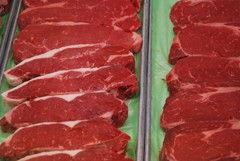Tips on Identifying Spoiled Meat
Ensuring any meat products you purchase are still good for consumption is very important, regardless of whether you’re the one who’ll be eating it or you work at a restaurant or for a catering company.
The signs of spoiled meat are relatively simple to pinpoint, and there is always more than one sign, regardless of the type of meat. In today’s blog, we’ll be looking at some of the clearest signs you should keep an eye out for that mean you could have spoiled meat in your possession.

Use By dates
Unlike other products, almost every single meat (whether beef, poultry, seafood, etc.) will have a use by date associated with it. This date literally means the meat must be used by this date. So if you’re looking for some meat to purchase at a grocery store, don’t forget to check its use by date. Some groceries or supermarkets can sometimes forget to remove spoiled products and still be selling them even when the use by date has passed.
Of course, the use by date may not be applicable at home if you froze your meat when it was still in good condition. Freezing meat essentially halts its ageing process, but you should still be cautious when thawing out meat. If you thaw it at room temperature as opposed to allowing it to thaw out slowly in your fridge for 24 hours, this can allow harmful bacteria to grow on it.
But unless your freezing meat when it’s still good, that use by date should definitely be acknowledged and adhered to.
Colour
Checking the colour of your meat will also give way potential signs of spoilage. While use by dates act as a point of guidance, this doesn’t stop the potential of meat going off beforehand, especially if its improperly stored.
For raw poultry, if the colour doesn’t run between a bluish-white to subtle yellow colour, then it could be off. In regards to raw pork, it will usually have a greyish-pink hue to it if it’s still good. When it comes to ground beef, it can be a bit harder to tell. The truth is it can still be good to eat if it is bright red (caused by exposure to oxygen), purplish-red (vacuum sealed) and brownish-red (meat from an older animal or caused by a reaction to certain lighting).
All the same, the bright red that can be associated with ground beef can also be extremely deceptive. This may be the result of carbon monoxide being used during the packaging process. This keeps ground beef a nice bright red but doesn’t necessarily mean the beef is fresh. That’s why along with looking at its colour, you should also consider the next identifying factor.
Smell
While stores may be able to deceive your eyes by keeping ground beef bright red thanks to carbon monoxide, they cannot stop smell. The issue is that carbon monoxide can keep ground beef’s bright red look even it has spoiled. The best solution is to actually smell the meat your purchasing. There isn’t much of a secret here. If it smells rancid and unpleasant, then that’s likely because it’s off or going off. The same applies with poultry, which actually tends to have an even more pronounced off-putting smell.
Don’t judge freshness on sight alone – incorporate smell, too.
Inspect
Going back to the visual side of things (and touch), you should also give any meat a thorough inspection. Even though its thorough, it really doesn’t take that long. One big sign of meat being spoiled is that its skin will be covered in slime. You’ll be able to tell this apart from the typical moisture that meat contains because the slime will show up in a film-like quality.
As for poultry, along with having a potential slime-like film on it, it also has a tendency to go sticky. So even if you’re at a store and can’t the meat itself, consider lightly pressing the protective plastic up against it. If it sticks and struggles to come unstuck, it could be cause for concern.
Now, regardless of the meat, mould has the potential of forming on all of them. Mould can manifest itself as a growth (the type of furry growth) or can start out as black or green discolourations on the skin of meat. Either way, if any of these signs are showing, it’s better to not take the risk.
Are there any other signs you’d like to add? Be sure to share them with us in the comments below.